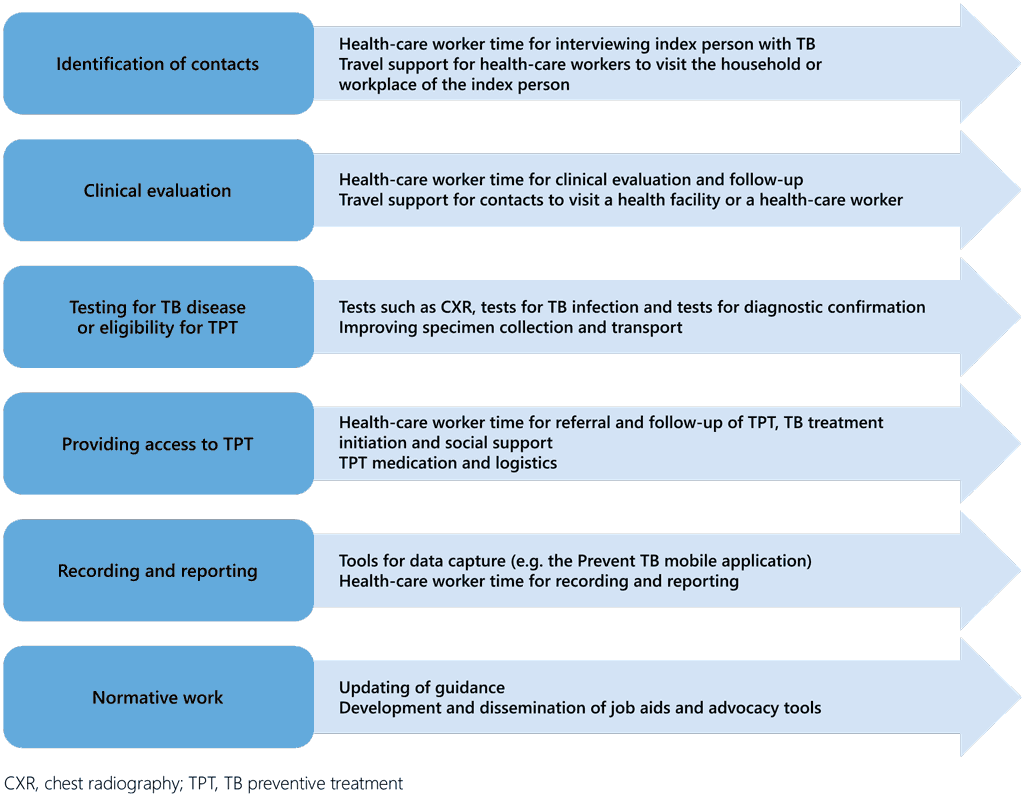كتاب روابط اجتياز لـ 1266
When preparing a budget for PMTPT, for example as part of a National Strategic Plan, it is important to conduct systematic costing. The TB module of the integrated health tool for planning and costing is designed to support national strategic health planning over the medium term (1). The WHO costing guidelines for tuberculosis interventions explain how to cost TB interventions from the perspective of the providers of health services and include tools for data collection (2). Listed below are key items that require costing when developing a budget for PMTPT.
Estimate the burden
- Populations of each target group (people with HIV, contacts, clinical risk groups, other risk groups)
- Number of households and other sites (health facilities, ARV centres) to be covered for expansion of TPT activities.
Investigating target populations
- Test for TB infection (TST/TBST/IGRA) as per national policy (such as test equipment general supplies, procurement fees for supplies, specimen collection and transport)
- Access to chest radiography services as per national policy (such as free vouchers for individuals, outsourcing chest radiography services to private providers)
- Referral for investigation (such as travel support for contacts, specimen collection and transportation)
- Integrate contact investigations into the roles and responsibilities of existing health and community workforce.
- Dedicate human resources as required to implement and to monitor implementation of contact investigations.
- Train and build capacity of health care workers, community workers and other implementers.
- Provide travel support or incentives for health care workers, community workers or other implementers of contact investigations.
- Provide travel support for index people with TB and contacts to reach facilities for screening, testing and continuation of TPT.
- Strengthen recording and reporting of data (updating existing electronic data systems with variables for PMTPT or adoption of digital tools such as the WHO Prevent TB mobile application (3).
- Generate awareness among patients, contacts and communities.
- Cost items for the strengthening of contact investigation are included in Fig. A3.1
Fig. A3.1. Indicative costing of items to strengthen contact investigations

Ruling out TB disease
- Support regular convening of and consultation with the national technical working group or a similar mechanism to review strategies for ruling out TB disease before TPT in target populations.
- Develop and implement a plan for human resource development, including hiring, training, mentoring and ongoing sensitization for TB screening, family counselling and evaluation of eligibility for TPT.
- If CXR is used for TB screening in national guidelines, funding will be required for
- equipment (such as for digital radiography, CAD),
- logistics,
- maintenance of equipment,
- training of clinicians and other health-care workers in reading CXRs, and/or
- hiring radiography services from the private sector (such as vouchers for a free CXR for individuals receiving care in public or private facilities).
- Extend access to rapid TB diagnostics, such as mWRD and lateral flow urine lipoarabinomannan assays.
- Establish or strengthen specimen collection and transport according to the requirements of different target populations (including children).
- Print and disseminate SOPs and job-aids for TB screening.
Testing for TB infection
The following are required for testing for TB infection:
- cost per test and estimated number of target populations to be tested;
- travel support for individuals considered for TPT and health-care workers to access TST/TBST and IGRA testing and TST/TBST reading;
- incentives for health-care workers and laboratory technicians;
- maintenance of a cold chain for tuberculin;
- training, capacity-building and ongoing supportive supervision;
- maintenance of laboratory services for IGRA and specimen collection and transport;
- hiring of laboratory technicians or laboratory services as required, including from the private sector;
- strengthening supply chain management to ensure an uninterrupted supply of tuberculin or IGRA blood collection tubes and reagents; and
- tools for routine data capture, preferably electronic.
TPT
The following are required for TPT:
- medications for regimens for different at-risk populations;
- procurement (such as freight, procurement fees, warehousing, repacking);
- additional drugs (such as buffer stock, supporting medicines such as vitamin B6); and
- support for adherence (such as phone calls, SMS, video communication, additional home visits)
Human resources
The following are required for human resources for TPT:
- additional personnel and/or incentives for community workers or volunteers;
- contact investigation:
- transport of health-care workers and
- transport of contacts to facilities for TB screening, investigation and TPT;
- TPT provision and follow-up;
- laboratory work;
- supervision and monitoring;
- drug distribution and management; and
- capacity-building and support:
- training for health-care workers and
- job-aids
Demand creation
The following are required to create demand for TPT:
- advocacy with policy-makers and key stakeholders;
- sensitization of specialists and health-care workers;
- community sensitization of TB survivors, people with HIV networks and others;
- counselling of index patients and families; and
- health education material for at-risk populations and their families.
Monitoring and evaluation
M&E require:
- data systems: electronic tools for recording and reporting; and
- updating tools or creation of new ones for recording data elements for programme indicators and clinical management (such as adverse events) for TB and/or HIV.
References
- TB module of the Integrated Health Tool for planning and costing. Geneva: World Health Organization; 2024 (https://tb.integratedhealthtool.org).
- Costing guidelines for tuberculosis interventions. Geneva: World Health Organization; 2019 (https://www.who.int/publications-detail-redirect/9789240000094).
- Prevent TB Digital Platform. Geneva: World Health Organization; 2024 (https://www.who.int/activities/preventing-tb).

 تعليق
تعليق